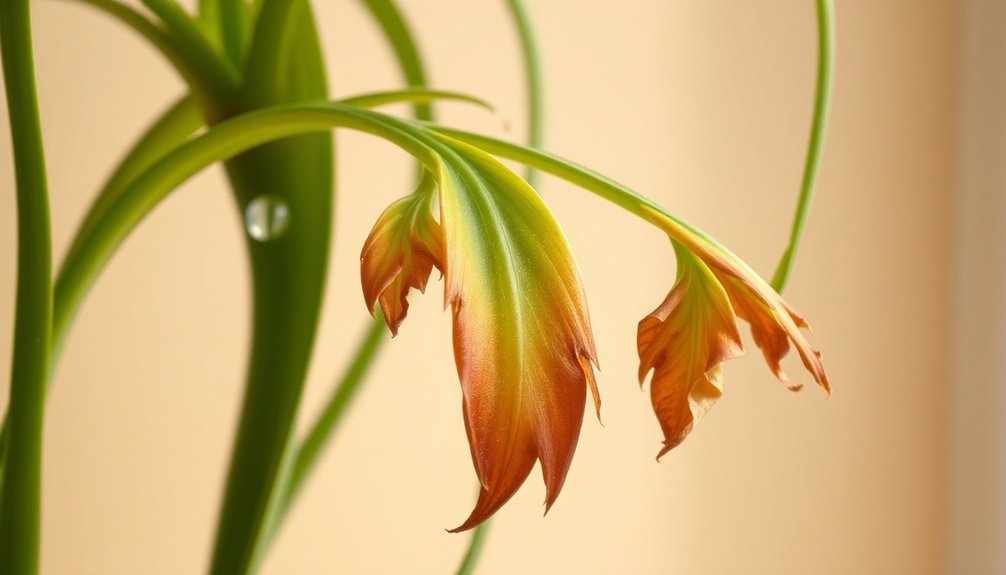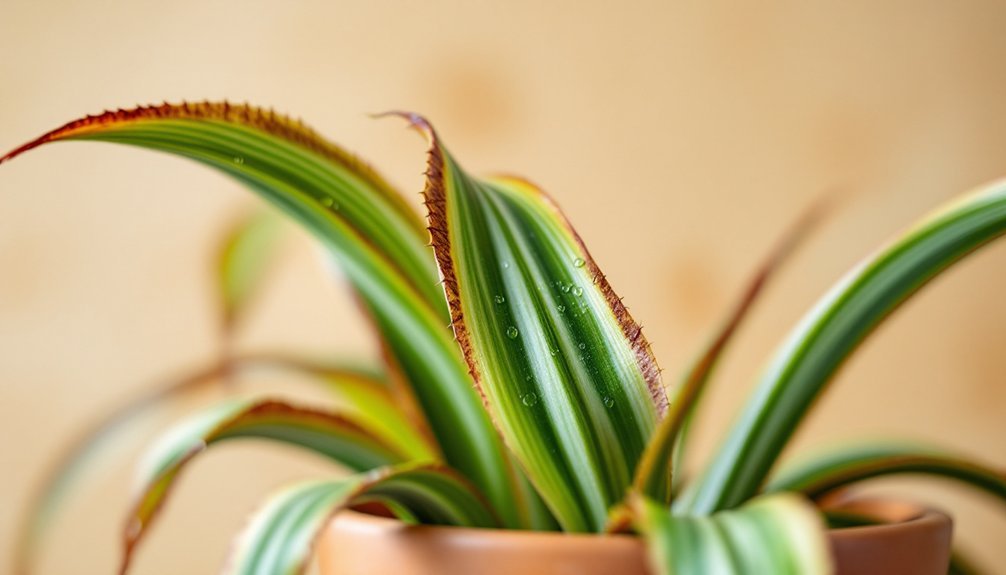Brown tips on your spider plant signal several common issues you'll need to address. Your plant may be struggling with low humidity (below 50%), chemical buildup from tap water, inconsistent watering, excess fertilizer salts, direct sunlight exposure, sudden temperature changes, or restricted root space. While these brown tips won't kill your plant, they do indicate stress that's preventing your spider plant from thriving. Understanding each factor will help you restore your plant's natural beauty.
Low Humidity Stress

While spider plants are generally adaptable houseplants, they can struggle when humidity levels drop below 50%. If you notice brown tips on spider plant leaves, low humidity is often the culprit, especially in homes with artificial heating or cooling systems.
Prolonged exposure to dry air can stress your plant and lead to crispy, discolored foliage.
To maintain a healthy plant, you'll need to boost the surrounding moisture levels to 50-60%. You can achieve this by regular misting of the leaves, setting up a pebble tray beneath the pot, or running a humidifier nearby.
Consider moving your spider plant to naturally humid spaces like your kitchen or bathroom. Taking these steps won't just prevent brown tips – it'll protect your plant from potential pest problems and diseases that can affect moisture-stressed plants.
Chemical Water Damage
Although spider plants are resilient, they're particularly sensitive to chemicals commonly found in tap water. Fluoride and chlorine in your tap water can accumulate in the soil, leading to chemical buildup that damages roots and prevents proper nutrient absorption. You'll notice this damage manifesting as browning tips on your plant's leaves.
| Water Type | Effects | Solution |
|---|---|---|
| Tap Water | Chemical buildup, root damage | Let sit overnight |
| Distilled Water | No chemical residue | Use directly |
| Rainwater | Natural minerals, no chemicals | Collect and use |
To protect your spider plant, switch to distilled water or let tap water sit out overnight to allow chlorine to dissipate. If you notice ongoing issues, try flushing the soil with distilled water to remove accumulated salts and chemicals. Regular monitoring of your water quality will help prevent future damage to your plant.
Improper Watering Patterns

You'll notice your spider plant's leaves developing crispy, brown tips when it's underwatered, while overwatering leads to root rot, characterized by soft, mushy roots and yellowing foliage.
To establish a proper watering schedule, check the top inch of soil before watering and implement a weekly soak-watering routine where you submerge the pot in water for 45 minutes.
Monitor your plant's response to this schedule and adjust the frequency based on environmental factors like light and temperature to maintain ideal moisture levels.
Underwatering Signs and Symptoms
Spotting the signs of an underwatered spider plant early can prevent lasting damage to your beloved houseplant. When you notice brown leaf tips turning crispy and leaves starting to droop, these are clear signs of underwatering.
Don't let your soil dry out completely, as this prevents proper water absorption and weakens your plant's overall health.
To maintain a healthy spider plant, you'll need to establish a regular watering routine. Check the top 2 inches of soil – if it feels dry to the touch, it's time to water your spider plant.
While weekly watering is typical, pay attention to your plant's specific needs based on its environment. Consistent dry soil can permanently damage your plant, so staying vigilant about moisture levels is essential for long-term plant health.
Root Rot Warning Signs
While spider plants are generally hardy, root rot poses a serious threat when improper watering leads to consistently waterlogged soil.
You'll notice yellowing leaves and wilting despite wet conditions, along with an unpleasant smell coming from the potting mix – all clear indicators of potential root rot.
To confirm if root rot is the culprit, carefully remove your plant from its pot and examine the roots.
Healthy roots should appear white or light tan, while affected roots will be brown and mushy.
If you spot signs of decay, you'll need to trim away affected roots immediately and repot your spider plant in fresh, well-draining soil.
Moving forward, prevent future issues by allowing the top inch of soil to dry between waterings, as overwatering is the primary cause of root rot.
Establishing Proper Water Schedule
Establishing a consistent watering schedule stands as one of the most essential aspects of spider plant care.
You'll need to monitor your plant regularly to prevent brown tips caused by improper watering patterns. Check the top inch of soil before adding water – if it's dry, it's time to water.
Your spider plant's needs will vary based on factors like insufficient light and humidity around the plant. During warmer months, you might need to water weekly, while cooler seasons require less frequent watering.
Consider using a soak-watering method by placing your plant in a water basin for 45 minutes to guarantee even moisture distribution.
Watch for signs of excess moisture, which can lead to root rot. Remember to adjust your watering schedule seasonally and avoid using water-soluble fertilizer when the soil is dry.
Fertilizer Salt Buildup

When fertilizer salts accumulate in your spider plant's soil, they can cause significant damage to the roots and leaves. Over-fertilization leads to excess nutrients building up in the soil, drawing moisture away from the roots and resulting in brown tips on your plant's foliage.
Excess fertilizer salts in spider plants create a toxic environment, pulling water from roots and leaving telltale brown leaf tips.
To prevent fertilizer salt buildup, you'll need to monitor your soil moisture and fertilization routine carefully. Use a balanced water-soluble fertilizer once monthly during the growing season, making sure to follow proper dilution instructions.
Don't forget to flush the soil thoroughly with water every few months to wash away accumulated salts and chemicals. This simple maintenance step helps prevent salt concentration from reaching harmful levels.
Additionally, verify your plant isn't sitting in standing water, as this can worsen salt accumulation problems.
Direct Sunlight Exposure
Direct sunlight poses three major risks to your spider plant's health and appearance.
First, prolonged exposure will cause leaf tip browning, damaging your plant's elegant appearance.
Second, intense rays can scorch the leaves, leading to permanent damage if not addressed.
Third, direct sunlight creates an unsuitable environment for a plant that naturally grows in tropical regions under forest canopies.
To protect your spider plant, place it where it'll receive filtered sunlight instead of harsh direct rays.
You'll find the best results by positioning it near north or east-facing windows, where it can enjoy gentle morning light.
If these window options aren't available, don't worry – you can easily create a suitable environment by hanging sheer curtains to filter intense sunlight and prevent leaf damage.
Temperature Fluctuations

Although spider plants are generally adaptable, they thrive best in stable temperatures between 65°F and 75°F (18°C to 24°C). When exposed to temperature fluctuations, your plant's moisture balance can become disrupted, leading to brown tips and overall plant decline.
Spider plants need consistency to flourish, with ideal temperatures of 65-75°F. Unstable conditions can stress the plant and cause browning.
To protect your spider plant from temperature-related stress, follow these essential guidelines:
- Keep your plant away from heating vents and air conditioning units that create sudden temperature changes.
- Move plants away from drafty windows, especially during extreme weather.
- Maintain a consistent humidity range of 50-60% to support healthy growth.
- Monitor room temperatures regularly, avoiding drops below 50°F (10°C).
Root Space Restrictions
Beyond temperature concerns, your spider plant's root health plays a major role in preventing brown leaf tips. When your plant experiences root space restrictions, it struggles with nutrient absorption and water uptake, leading to those unsightly brown tips and reduced growth.
Your spider plant needs room to breathe – if it's pot-bound, with roots emerging from drainage holes, it's crying out for more space. To maintain ideal conditions, choose a container that's 1-2 inches larger than the root ball.
You'll want to repot every couple of years to prevent overcrowding. Keep an eye on your plant's root system by checking periodically; if you notice roots circling the bottom or sides of the pot, it's time for an upgrade.
This simple maintenance will help prevent stress-induced brown tips.
Frequently Asked Questions
How to Fix Spider Plant Brown Tips?
You'll need to water consistently, increase humidity, flush soil with distilled water, reduce fertilizer use, and move your plant to indirect light. Don't forget to trim brown tips with clean scissors.
Do Brown Tips Mean Overwatering?
While brown tips can indicate overwatering, they're not always caused by it. You'll need to check other signs like soggy soil and yellowing leaves to confirm if overwatering is your specific issue.
How Often Should a Spider Plant Be Watered?
You should water your spider plant once a week, but check the top 2 inches of soil first – if it's dry, it's time to water. You'll need to water more in summer, less in winter.
What Does an Overwatered Spider Plant Look Like?
You'll notice your overwatered spider plant has yellowing, wilting leaves with a mushy texture. The soil will feel soggy, and there's often a foul smell. You might also see brown tips and dropping leaves.
In Summary
Spider plants commonly develop brown tips, but you've now learned the key causes behind this issue. By maintaining proper humidity, using filtered water, developing consistent watering habits, managing fertilizer use, protecting from harsh sun, stabilizing temperatures, and ensuring adequate root space, you'll keep your spider plant's leaves green and healthy. Don't worry – with these adjustments, you can prevent future browning and restore your plant's vigor.





Leave a Reply